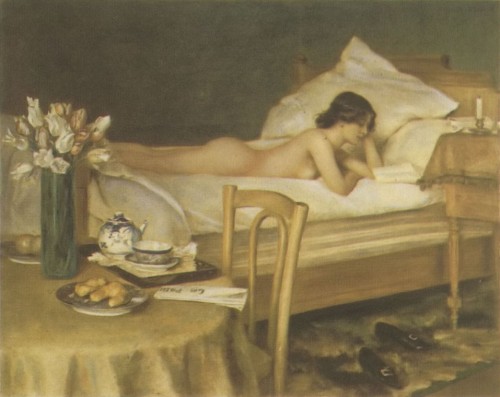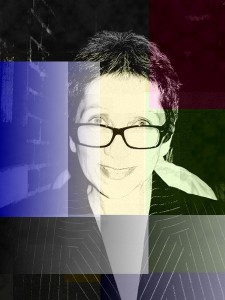
“Der Bücherwurm” (The Bookworm), by Hermann Fenner-Behmer
Sometime in my early twenties I wandered into a gallery of contemporary abstract art in Edmonton. It’s possible I was just getting out of the cold for a minute. Art hadn’t yet entered my life in a big way, and I’d certainly had no exposure to abstract work. Seeing it fill a room, I was struck by the colours and shapes, intrigued, but I didn’t understand how it could be art … what was artistic about blobbing paint onto a canvas? So with all the smugness of the ignorant, I asked the gallery owner that very question, in pretty much those exact words. I can still remember how earnestly she answered — as if it were very, very important that I understand this.
She began by insisting that any artist worth their pigment would approach the work from a different place than blobbing. That might be how it appeared to anyone watching, and freedom was sometimes the motivation in this work, she said, but the painter would also possess an understanding of the fundamentals, the basics of structure, balance, and light, and they would most likely have studied the classic and most difficult subject: the nude. All this, she said, regardless of their own unique and personal style. That would come later.
I don’t remember many exchanges from my twenties, but I had the feeling that what she was telling me went beyond painting, and I’ve thought about it countless times and in different ways over the years since.
It was the idea of the nude that got to me. Who would ever make the connection between the human body and all those red and orange squares, that splash of green on a canvas? I began to wonder if every discipline had its form of nude. Is it scales to a musician, a basic white sauce to a chef? What is it for a sculptor, a dancer, a glass blower?
A few years later I took my first writing workshop. The instructor talked about the importance of reading. Not a problem, I thought. I like to read. Next! But there was no next. Reading was his sole focus for the entire workshop. How to read. I was stunned. What a waste of time. I already knew how to read. I was there to learn how to write.
He talked about the scope of literature, that everything from Shakespeare to Alice Munro was fodder for study, and that study was less about appreciating collective words on a page than about analyzing the choice of those words, the form of those sentences and paragraphs. He explained how it was these components, not clever-clever ideas, that made the whole thing live and breathe and move, and that the approach to writing had to be from the inside out, which meant an understanding of structure, not merely story.
Once again the nude came to mind.
Reading, of course, was the literary nude. But not just reading. Close reading.
In exactly the same way that it’s not enough to paint or sculpt the human form by merely looking at it, or even admiring it, we can’t learn to write by merely reading. The popular advice to students of writing to Read read read! And then read some more! is excellent, of course, but loving books isn’t all there is to studying craft. Craft is knowing what’s beyond the shape of what we’re reading, looking past the outer “skin,” the words, and finding the structure that exists in every story — the style, wordplay and rhythm; the cycles of romantic, tragic, ironic, and comedic modes. Where is the tension, and how do scenes shift? How did we get from here to there? It’s finding the bones and the musculature that gives a story the ability to stand on its own before it’s dressed with the details of action, character, and dialogue.
Francine Prose, in her book How to Read Like a Writer, says we’re born with the instinct:
“We all begin as close readers. Even before we learn to read, the process of being read aloud to, and of listening, is one in which we are taking in one word after another, one phrase at a time, in which we are paying attention to whatever each word or phrase is transmitting. Word by word is how we learn to hear and then read, which seems only fitting because it is how the books we are reading were written in the first place.”
And then we grow up. And we get busy. And no one reads to us anymore. And we don’t listen all that well anyway. But so what? I don’t actually think there’s anything wrong with getting through a stack of books a little too quickly, because, well, just LOOK at that stack … or reading simply because we enjoy it … as long as we make time for The Other — the slow, deliberate read. (I’ve discovered that dissecting one short story by Alice Munro is easily worth a month of “pleasure reading.”)
We have the idea we know what an ankle bone looks like, but unless we truly focus on it — and probably for longer than we ever thought necessary — unless we take the time to notice how it’s connected to the leg bone, we run the risk of being a blobber.
Which, I’ve come to realize, is an entirely different thing than blobbing with intention.
♦ ♦ ♦
 When not writing, CARIN MAKUZ can be found wandering the shores of Lake Ontario muttering about darlings that won’t take a hint. She is a workshop facilitator for abused women and youth at risk. Her work has been published widely in journals in Canada, the U.K., and the U.S. and broadcast on CBC and BBC radio. She is the creator of The Litter I See Project, and combines text with photography, reviews books, chats with writers, and generally thinks out loud on her blog Matilda Magtree.
When not writing, CARIN MAKUZ can be found wandering the shores of Lake Ontario muttering about darlings that won’t take a hint. She is a workshop facilitator for abused women and youth at risk. Her work has been published widely in journals in Canada, the U.K., and the U.S. and broadcast on CBC and BBC radio. She is the creator of The Litter I See Project, and combines text with photography, reviews books, chats with writers, and generally thinks out loud on her blog Matilda Magtree.
Indeed, you’ve nailed the essence of many art forms Carin – writing, painting, sculpture, music. It’s as though you can’t undo until you’ve learned how to do. How beautifully you’ve interpreted it for us.
Thanks, Allison. Funny the things that stick with us. For someone who is happiest in clothes, it’s a weird image I cling to… (:
A thoughtful and thought-provoking essay, Carin. I’d wouldn’t like to be considered “a blobber.”
True story: Hubby used to do printing work for AGO. He saw a “line and blob” painting and said to the curator, “That makes no sense to me.” The curator said, “That’s why I’m the curator and you’re the printer.”
Ha! Brilliant line. Crosses many boundaries… (: